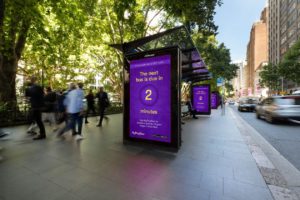Incredulously, and for the superstitious paired with a sigh of relief, the end of the year less ordinary 2020 is in sight. No doubt, a year to remember and one remaining in our social consciousness as a caesura point for years to come. As we dive deeper into the final quarter of the year we thankfully have only good digital signage news to report.
For a start, this month we saw a stellar example of dynamic outdoor advertising with the JCDecaux and MyPayNow OOH campaign. Among other things, the controversy of banning billboards brought up interesting points to their merit and whether or not they should be banned in certain locations. Lastly, we’ll highlight key features to look for in digital signage software before deciding on one.
The JCDecaux/MyPayNow dynamic digital signage campaign
A great example of dynamic digital signage campaigns comes from JCDecaux and the cash advance app MyPayNow. Nationwide in the US at JCDecaux bus shelter displays bus arrival times were shown with the advert for the MyPayNow app. This is an instance where a dynamic digital signage campaign offers useful information to commuters while keeping creative focus on the advertisement. As the display showed the arrival time, the ad highlighted what a user could do with the MyPayNow app within that wait time.
Dynamic digital signage campaigns are a worthwhile path to inject creativity into your content. They pull in real-time factors into your message and as they are helpful they get noticed with an impact!
A new event emerges, presented by DSF and AVIXA
Digital Signage Federation and AVIXA have recently announced about working together on a special virtual event, taking place on the 8th and 9th of December. The event is called D=SIGN and will focus on digital signage hardware, software, and content strategy.
The event will among other things feature technology presentations. Given that DSF and AVIXA present the event, it will likely focus more on the overall education within the industry, rather than pitching certain products or solutions.
Are billboards too beneficial to ban?
As a group of citizens of Utah call for a billboard ban claiming they’re eyesores, a new question arises. Billboards can indeed be an annoyance, but they do offer benefits which are often overlooked.
An article over at DesertNews discussed this in more detail, and here are some key points. Firstly, billboards are used to solve problems. The National Highway Traffic Safety Administration uses digital billboards to promote safety. For instance, they urge drivers to buckle up, and not drink. The benefit of billboard PSAs during the COVID-19 pandemic is another example. There is also the point of innovation which drives the economy. The advancement of traditional billboards into digital enables the content they display to be more precise and relevant. This success persuades people to inject money into the economy by investing in them.
Has the pandemic made people appreciate the outdoors more?
COVID-19 has made a big impact on customer behavior, but how deep does this impact run? Posterscope, a global OOH and location-marketing firm, made an interesting discovery. 70% of UK consumers claim to be more mindful of their surroundings, especially in local areas. Many claim they found a stronger emotional connection with their local community.
This also applies to outdoor advertising. 40% of respondents from “The Mobility Mindset” study claim they feel more positive towards brands who currently use OOH than before the pandemic. This confirms that outdoor advertising has the ability to build connections. In the end, this is hardly surprising. We all tend to appreciate things more once we are aware there is even the slightest chance of losing them.
The latest mobility reports
Geopath mobility reports appear to show fluctuation in reference to pre-covid levels. However, they’re typically always above 90%. Good news comes from other locations as well, such as Australia. Based on their mobility data, the visits to shopping centres are up to 93% of normal levels.
However, an OOHToday article raises a valid point when claiming that these numbers shouldn’t be taken too seriously. While it’s important to compare the current traffic numbers to pre-covid levels, let’s not ignore the fact that traffic fluctuates throughout the year as well. Thus, perhaps including a comparison based on a year-on-year period may be more relevant. Overall, based on recent data, it’s safe to say that traffic can be regarded as normal, give or take a few percentage points.
Tips on choosing the ideal digital signage software
To wrap up this set of digital signage news, we highlight one of the more important topics we wrote about this month. Digital signage software comes in a variety of shapes and sizes. One digital signage software type will suit your business better than another will. But no matter the recommendations, it’s important you understand the basics and know which key features to look for as you do your research. Only then should you proceed to take advantage of free trials and test the software before committing.
A comprehensive dashboard, proof-of-play reports, as well as the ability to find and fix errors quickly are essential. The interface should be easy to understand and use. You and I may be dedicated enough to put in the extra effort to learn a challenging interface. But think of other users within your management and how they should be able to quickly learn the ropes. Take a look at other essential features, including those which might not necessarily come to mind now, but as you grow your digital signage network, you’ll find them invaluable!









